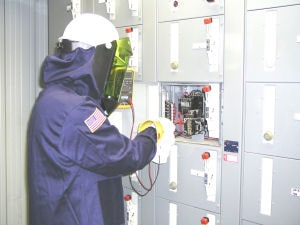Mining Topic: Electrical Safety
What is the health and safety problem?
Electrical accidents are a leading cause of mining fatalities, accounting for over 6% of deaths between 2000 and 2009.
What is the extent of the problem?
Compared with other industries, mining is among the most dangerous with respect to electrical injuries. U.S. Bureau of Labor Statistics data for 2003 to 2009 reveal that the mining industry has an electrical fatality rate approximately 8 to12 times the rate for all U.S. industries. Considering both fatal and non-fatal cases, electrical injuries are disproportionately deadly. Mine Safety and Health Administration data for 2000 to 2009 show one fatality for every 22 electrical-related injuries, compared with an average of one fatality for every 203 injuries for all other injury types in mining.
How is the NIOSH Mining program addressing this problem?

An electrician using a meter to test a 480V circuit, while wearing electrically-rated gloves, arc-rated face shield, and an arc-rated protective jacket.
Researchers at the NIOSH Mining Program have addressed the prevention of mining electrical injuries over the years with numerous studies focusing on power system design, engineering controls, work organization and procedures, protective equipment, and human factors. Much of this work utilized the NIOSH Mine Electrical Laboratory.
What are the significant findings?
Research findings have included methods to avoid electrical cable hazards, improved power system grounding, techniques for preventing electrical ignitions which could lead to fires and explosions, recommendations for improved overhead electrical power line safety, strategies for mitigating arc flash hazards, and better understanding of electrical accident causes.
What are the next steps?
Future electrical safety research by NIOSH will continue to address issues and hazards that have been linked to many past electrical injuries, as well as potential hazards from new technology. Examples include shock and burn hazards associated with switching equipment and cables, improved training, battery safety, and equipment permissibility.
- An Alarm to Warn of Overhead Power Line Contact by Mobile Equipment
- Arc Flash Awareness
- Derating Factors for Round and Flat Mine Trailing Cables
- Detrimental Effects of Capacitance on High-Resistance-Grounded Mine Distribution Systems
- Electric Shock Prevention
- Electrical Accidents in the Mining Industry, 1990-1999
- Electrical Injuries in the US Mining Industry, 2000-2009
- From Scotia to Brookwood, Fatal US Underground Coal Mine Explosions Ignited in Intake Air Courses
- Look Up, Look Down, Look Out
- Occupational Electrical Injuries in the United States, 1992-1998, and Recommendations for Safety Research
- A Performance Evaluation of Two Overhead Power Line Proximity Warning Devices
- Trends in Electrical Injury in the U.S., 1992-2002
- U.S. Bureau of Mines/NIOSH Mining Electrical Safety Research: A Legacy of Protection Against Shock, Fires, and Explosions
- Understanding and Quantifying Arc Flash Hazards in the Mining Industry